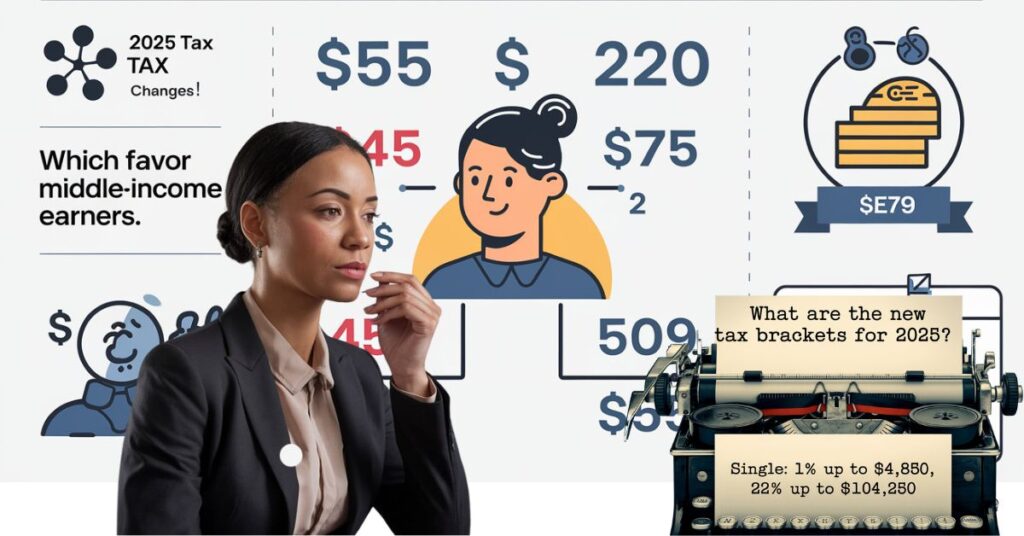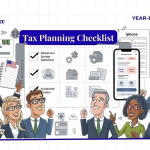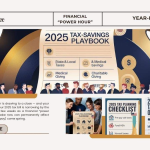IRS Updates for the 2025 Tax Brackets Year (Filed in 2026)
As we head into the 2025 tax year (with returns filed in 2026), the IRS has announced inflation-adjusted federal 2025 tax brackets and deductions that bring good news for middle-income earners. These changes are designed to prevent “bracket creep”—a phenomenon where inflation pushes taxpayers into higher tax brackets even if their real (inflation-adjusted) income has not increased.
The goal? To ensure you’re not paying more in taxes just because of inflation—and to help working families keep more of their hard-earned money.
Let’s break down the 2025 IRS changes, what they mean for your wallet, and how to use smart strategies to maximize your savings.
🧾 Key Changes by IRS: 2025 Tax Brackets (Filed in 2026)

1. Wider Tax Brackets Help Reduce Your Tax Bill
The IRS adjusts tax brackets every year to account for inflation. For 2025, these bracket expansions mean more of your income is taxed at lower rates—especially helpful if your income has stayed relatively flat.
Updated Federal Tax Brackets:
2025 Tax Brackets, released by the IRS, include tax inflation adjustments for the tax year 2025

2025 Tax Brackets For Single Filers:
- 12% tax bracket: now applies to income up to $48,850 (up from $47,150 in 2024)
- 22% tax bracket: now applies to income up to $104,250 (up from $100,525)
2025 Tax Brackets For Married Filing Jointly:
- 12% tax bracket: income up to $97,700 (up from $94,300)
- 22% tax bracket: income up to $208,500 (up from $201,050)
💡 Why It Matters: These expanded brackets mean more of your income is taxed at lower rates—even if you didn’t get a raise. That can translate into real savings.
Also read, New Tax Relief: How the 2025 Inflation-Adjusted Tax Brackets Will Give You More Money to Keep
2. Higher Standard Deduction = Less Taxable Income
The standard deduction—the amount you can subtract from your income before taxes—has also increased:
- Single filers: $15,100 (up from $14,600)
- Married filing jointly: $30,200 (up from $29,200)
💡 Why It Matters: The higher the standard deduction, the less of your income is taxable. This alone could save hundreds of dollars, especially for families who don’t itemize deductions.
3. Other Inflation-Linked Tax Changes
- Alternative Minimum Tax (AMT): The exemption has been increased to $87,900 for single filers.
- 401(k) contribution limit: Up to $23,500 (from $23,000).
- IRA contribution limit: Increased to $7,000.
- Health Savings Accounts (HSA): Up to $4,300 for individuals, $8,600 for families.
💡 Why It Matters: These expanded contribution limits allow you to shelter more income in tax-advantaged accounts, reducing your tax bill today while saving for tomorrow.
💵 How Middle-Income Earners Benefit from 2025 Tax Brackets

Here’s how the new brackets and deductions translate into real-world tax savings—even for those with steady incomes:
| Scenario | 2024 Tax Due | 2025 Tax Due | You Save |
|---|---|---|---|
| Single Filer ($60,000) | $5,216 | $5,010 | $206 |
| Married Couple ($120,000) | $10,432 | $10,100 | $332 |
| Middle Manager ($105,000) | $14,941 | $14,500 | $441 |
💡 Takeaway: Even without a raise, you can pay less in federal income tax thanks to broader brackets and higher deductions.
Read full details of IRS Updates for 2025: New Savings Opportunities. Find Out How To Leverage?
✅ How to Maximize Your Tax Savings in 2025

To make the most of these changes, consider the following tax-saving strategies:
1. Max Out Pre-Tax Retirement Contributions
- 401(k): Contribute up to $23,500 in 2025.
- Traditional IRA: Contribute up to $7,000.
This reduces your taxable income now and builds your retirement savings.
Try this Retirement Calculator and Plan Your Future & Achieve Financial Security
2. Use Health Savings Accounts (HSAs)
If you have a high-deductible health plan (HDHP), HSAs are triple tax-advantaged:
- Contribute up to $4,300 (individual) or $8,600 (family).
- Contributions are tax-deductible, grow tax-free, and withdrawals are tax-free if used for medical expenses.
Also read, Medical Expenses: Claim Tax Deductions for Significant Healthcare Costs
3. Leverage Strategic Deductions
- Charitable Contributions: Consider “bunching” donations to exceed the standard deduction in certain years.
- Tax-Loss Harvesting: Sell underperforming investments to offset capital gains elsewhere.
4. Be Aware of State Taxes
While federal savings are nice, remember your state income tax situation:
- No state income tax: Texas, Florida, Nevada, etc.
- High-tax states: California, New York, Illinois, etc.—where state tax bills may offset federal gains.
🧐 Will You Pay Less in 2025?

For many Americans, the answer is yes—especially if your income grows slower than inflation. The expanded brackets, bigger deductions, and contribution increases can combine to lower your tax burden, even if your salary remains steady.
✔️ Use the IRS Tax Withholding Estimator (Updated for 2025)
You can check and adjust your paycheck withholdings to reflect the new tax laws and avoid an unexpected bill—or refund—at filing time.
CheckTax Withholding Estimator Provided By The IRS
🔍 Top 5 Most Googled Questions About 2025 Tax Brackets

1. What are the new tax brackets for 2025?
- Single: 12% up to $48,850, 22% up to $104,250
- Married filing jointly: 12% up to $97,700, 22% up to $208,500
2. Will I pay less in 2025?
Most likely, yes—if your income didn’t grow faster than inflation.
3. What is the standard deduction for 2025?
- $15,100 (single)
- $30,200 (married filing jointly)
4. What is the 22% bracket in 2025?
- Single: Income from $48,851 to $104,250
- Married: $97,701 to $208,500
5. How can middle-class families lower their taxes in 2025?
- Max out 401(k) and HSA contributions
- Use charitable donation timing and tax-loss harvesting
📌 Final Thoughts on 2025 Tax Brackets

The IRS’s 2025 tax changes offer a rare win for middle-income earners. With inflation still top of mind, these updates provide some relief—and a real opportunity tolower your tax bill proactively.
Thoughtful planning, even now in 2024, can position you for a lighter tax hit next spring.
Pro Tip: Use theIRS Tax Withholding Estimator (updated for 2025) to adjust paycheck withholdings and avoid surprises at tax time.
Thank you for reading this post, don't forget to subscribe!






